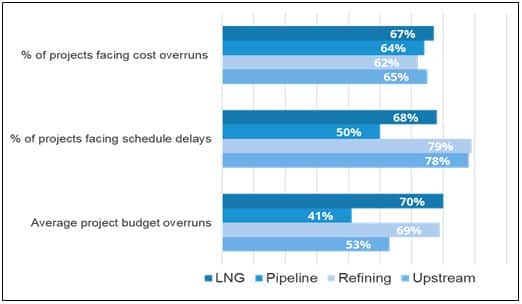Starting the New Year energized and motivated you yet not entirely meeting your resolutions? This may seem to be a yearly reoccurrence. With all that goes into managing a project, making sure things are done right, within budget, and on time is a challenge; especially when we fall victim to the same mistakes.
Knowing that there are a lot of moving parts that go into making a project successful, I have compiled a list of the most common project cost management problems that I have seen and my proposed solutions to fix them.
1. Being Reactive Instead of Proactive
Proactive project managers are people who focus their efforts and attention on the long-term as opposed to being reactive in the present moment.
This is a golden rule, though it may seem obvious, one of the most difficult to put into practice as well as one of the major causes for cost overruns.
In many cases, project managers find themselves putting out fires as they come. They may fall in a trap where they believe saves on cost if they deal with problems as they come, but then something unexpected comes along and disaster hits. The project gets derailed, people are scrambling to get the issue fixed and thus delaying their other tasks, and unexpected expenses must be made to save a situation. Even with a great team, they will have neither the time nor opportunity to explore the right solutions necessary. It is much more difficult to look back and rework vs. having a plan already in place for situations like this.
It is so important to act proactively rather than reactively to avoid leaving your project vulnerable to further failure.

How to Avoid Being Reactive?
When it comes to Proactive Cost Management, we recommend the following regarding Cost Estimation:
Build a foundation for success in the cost estimate
Though many times overlooked or even pushes aside, many fail to see the importance of a robust Estimate. This is the foundation/basis of all projects. The more detailed and precise the estimates the better project managers can predict and respond to events in a project not to mention minimize surprises.
Incorporate Lessons Learned and process improvements from prior projects to help build upon past mistakes and or successes.
Cost estimates and Budgets should marry
Translating cost estimates to budgets should be seamless without going through the hassle of restructuring your estimate to fit. For example, in the Cleopatra solution, the user has the ability to link an estimate to the cost module, in other words, the system has the ability to create a budget document for execution based on the approved estimate. The item and breakdown structures align preventing discrepancies between the estimating team and cost team. The comparison is apples to apples.
Make sure the project has a way to monitor and manage Earned Value Management and Cost Variances
A dedicated EVM tracking tool that compares the planned performance to the actual schedule and cost performance, is recommended.
Determine how the forecast will be measured (Estimate at Complete (EAC) vs. Estimate to Complete (ETC). Perhaps different items need different forecasting methods. Ensure that this is identified and communicated. Ensure that your project system has the flexibility to adjust forecasting methods and formulas clearly and transparent.
Identify Valuable KPIs. There is a fine line between Key Performance Index and general metrics. Identify and define which metrics are the “key” indicators that must be tracked and will be used to identify if something needs attention. This allows the project team to proactively address potential cost overruns.
Aligning with project processes is essential. Ensure from an early stage that these are clearly understood throughout the team and that the systems used have the ability to align and generate results per those processes.
2. Poor Communication & Visibility With Stakeholders
The method of communication when it comes to showing how the project is doing is through reports. Living in the digital world, it is no longer acceptable to have outdated information, where this data can be seen in real-time. Not only that, but it is important for a project to establish standardized reporting. Different report formats can cause confusion and is a risk to maintaining data integrity; information can be lost if the team does not communicate the data consistently.
Visibility or Perceptibility for the project team is important to consider when analyzing reports. How a project manager perceives a report can be different to how executives/stakeholders view it. Ensure the reports can be reported at different levels if needed, and provide appropriate access to dashboards that allow them to make accurate, well-informed decisions.
Even when simple task dates and progress are not communicated to the team this means that protocols are not followed for change management and status updates are not being communicated effectively to stakeholders and other team members. It is important to have costs and changes tracked in one place for a single source of truth, preferably a Project Cost Management Software.
In the previous section, it was mentioned that estimates play an important role as the foundation of a project’s cost. Having a tool that integrates estimating and cost management together (and is flexible enough to integrate with scheduling tools and accounting systems), the information given is more reliable and thus ensures effective communication.
3. No Standard Work Breakdown Structure (WBS)
A WBS is a visual, hierarchical breakdown of a project’s objectives and scope. This outline breaks tasks down into smaller tasks to ensure objectives and deliverables are met and allocated in the right “buckets” along the way. Budget costs rely heavily on this. This can be tedious to manage if the cost tool in place does not allow for the user to create, manage and assign cost components easily.
Cleopatra Enterprise, for example, is flexible enough where the user can copy breakdown structures from another source or create as many WBS as needed. This not only allows for a strong hierarchical classification, but also can be used for reporting, metrics, and interfacing with other cost related documents. It allows for multiple breakdown structures in one estimate. This is important when dealing with third parties where they may report in a different way than that of your project yet still allowing you to work with your company specific breakdown structures.
4. Underestimating Time & Budget Needed
Below is an image that shows the results of a study conducted by Ernst & Young in 2014. Completion costs are 59% higher than initial cost estimates on average, representing an incremental cost of US$500b. Upon analyzing around 365 mega projects, research showed that 64% of projects are facing cost overruns and 73% reported schedule delays.
There is no denying that time and budget are heavily underestimated by project teams everywhere.
Information is power, project managers should take the time to learn about how projects have been and are performing. Are they showing delays in schedule and/or overruns? Knowing this will help to determine any trends that are or have been occurring. What types of costs are being overlooked and why? A lot of these issues can be avoided by project managers if they ask themselves the following questions:
- Do I have enough resources right from the get-go?
- Do I have the proper system to analyze and compare conceptual/parametric estimates of different classes?
- Are we able to produce detail estimates based on MTOs or create cost objects in assembly structures?
- Are we able to produce and tie our estimates into Resource / Staffing Estimates?
- Are we able to analyze the effect different scenarios may have on our estimates (“What-if” Cost Analysis)?
- Do we have a way to internal benchmark our projects so that we can refer to previous projects to help our future estimates?
5. Using Spreadsheets (Lack of dedicated PM Tool)
It is almost shocking to see the number of projects that are still using spreadsheets for their cost analysis and management needs as their main tool. Excel does have its advantages such as that it is readily available, easy to start off with, it’s completely tailor-made (by you), and it is something that we’ve been doing for years. However, with regards to managing a dedicated discipline such as Cost Management within a major project, Excel falls short. Some of the challenges with Excel include:
- No dedicated functionality
- Mistakes are easily made (data integrity)
- Risk of becoming overly complex
- Typically depending on one owner (the tailor)
- No versioning capabilities
- Limited reporting & visual capabilities
Having a dedicated Project Cost Management Software is just as the name states – it is dedicated to managing project costs. It is designed to help analyze and organize project cost information in one source where functionality such as creating work breakdown structures, selecting forecasting methods, linking estimates, integration with other tools, visibility to different team members, etc. is all possible with the risks that Excel has. That said, benefits of one tool should not be sacrificed for another. Finding a dedicated software that allows the same flexibility that Excel has is just as important. Below are other reasons why having a dedicated Project Cost Management software is beneficial:
- Out-of-the-box cost control and EVM functionality
- Data consistency is safeguarded
- Change & Progress Management
- Predefined metrics such as CPI & SPI
- Versioning & snapshots
6. Forgetting that Project Management is also People Management
It is not all about crunching numbers. A project manager is considered a leader who guides the team towards success by working together, and encouraging ideas and boosting morale..
Failing to properly manage team members or micromanaging them, can lead to delays, impact quality and result in cost overruns. Team members are the people most in touch with the challenges, risk and issues likely to impact the project
It is also a misconception when executives think that a strong system will solve all project issues. If the team is being managed properly and they understand the processes and understand their work and roles, then they will be able to input valuable information into the tool. A tool is merely a tool without the properly trained individuals who know how to use and what information is needed as an input and output.
Thus, project managers should:
- Make sure the team understands their Roles and Responsibilities and their importance.
- Recognize Team’s Successes.
- Celebrate the small successes, any extra effort that contributes to advancing the team’s mission.
- Develop a performance review system as part of your project management plan.
- Ensure that performance is measured, reviewed and recognized.
Another issue when it comes to managing people is micromanagement. There are some pros to this especially within small companies. Micromanaging can be a hassle and event detrimental to the project team. It also takes a lot of time from the project manager. See below to compare the pros and cons of micromanagement:
MICROMANAGEMENT:

7. Failure To Adjust Or Change When Things Go Wrong
There are typically two types of fears; fear of failure and fear of change.
Every project manager should know that, sometimes, despite their best efforts, things go wrong or the project fails. Sometimes, due to a fear of failure, project managers try to salvage a failed project and this could lead to radical decisions causing more damage and costs than needed. Instead they should take a step back and re analyze their position and adjust where necessary.
This is why it is important to have a system or tool that creates transparency and truthful reporting.
Yet despite this knowledge, there are many managers who also fear change or refuse to make changes to the way they are used to doing things. When something is not working, something needs to change. As Thomas Jefferson said, “if you want something you never had, then you got to do something you have never done.”
There is also a resistance to every changing technology. There are many who believe that changing will just cause more work, more risks, more cost. This may sometimes be true initially but one must evaluate the long-term results as well. If something is not working or a process / technology is not at the level it should be (in this fast pace world) not adjusting and making the necessary changes can lead to terrible results.
As Bill Gates would put it, “The people who resist change will be confronted by the growing number of people who see that better ways are available; thanks to technology.”
8. Lack of Integrated Project Controls
Many different departments work together to make a project work, or at least they should be working together as seamless as possible. What we have seen, however, is that these different departments work as if they are in their own silos and thus not integrated.
According to the AACE (Association for the Advancement of Cost Engineering) the proper way to manage a project is to ensure the information is running through an integrated approach instead of a collection of individual disciplines. Some of the most common challenges faced due to lack of integration is a lack in standardized reports, information discrepancies, different departments responsible for their own ‘shop’, etc.
Working towards an Integrated Project Controls Approach can have numerous benefits such as:
- Significant improvements can be expected by increasing the level of IPC
- More accurate and reliable (early phase) estimates
- More time to focus on analysis
- Increased profitability on projects through less overruns and more efficient work processes.
Cleopatra Enterprise encompasses this structure in its framework. Being a flexible modular based system allows for the different parts of a project at its different phases to integrate together.
The foundation for a successful project is a sound estimate, and delivering the budget. Once the budget is determined a schedule has to be made to determine the order of activities and the resources involved. During project execution we help to ensure that our clients stay within time and budget. On project close out all relevant data has to be captured in order to perform big data analysis to improve estimates for future projects.

9. No Consistent Project Close Out
Everyone knows it is important, yet few organizations do it properly. This is where lessons learned can be used to improve the success of future projects. So much time and effort go into a project, why throw away all that work?
Most of the time we find ourselves rushing towards the next thing and not knowing how to properly capture important information and analysis done on a completed project. Spending some time on this actually adds value to your future project and avoids unnecessary rework. It is in our old projects where we can find, for example, the missing link between actual costs and hours spent and early phase (class 5/4) estimates.

Some project managers like to benchmark against the market, but neglect to benchmark internally. Having an integrated project cost solution with an internal benchmarking feature can allow for easy project close out and access to valuable information where one can capture and index costs of a prior project to compare with a current one.
10. Not Making Time to Learn
Knowledge is Power. The more we learn the more we are capable of solving issues and be open to solutions. Yet we always seem to be “too busy” for learning, attending seminars, networking, webinars, or even reading about what’s new in the market.

Our past experience can only take us so far if we are not open to the new and what future generations have to say. We just can’t be closed-minded in this fast-paced world anymore. It is the same as doctors not attending their seminars and not aware that there is a new medicine that can cure a deadly illness. Same goes for project managers.
Whether it be for their jobs or just personal growth, adding value to oneself by adding knowledge makes for a great leader. Project Managers should make time for themselves to expand their horizons and hear what others think or have to say. And who knows you may get a free lunch out of it – especially in our monthly Cleopatra Lunch and Learn events.
In conclusion,
As mentioned, there are so many moving parts when it comes to project management and many pitfalls that we can identify – some we may have not mentioned in this list. These were just some of our choices.
We hope that this information provided some value to you and your projects. It is so important for us to be aware of these errors and try to learn from these mistakes.
Below is a summarized list of recommendations:
- Assess your organization’s Integrated Project Controls maturity
- Be Proactive!
- Implement and make use of today’s technology and (software) tools
- Do not underestimate the importance of Estimates and Cost
- Standardize Reporting Structures
- Ensure the project has the ability to create customizable Dashboards.
- Understand the importance of Earned Value
- Ensure proper close-out on projects
- Communicate Real-Time Data
- Understand how you compare with similar projects within your company (internal Benchmark)
About the Author, Natalia Urquiaga

Natalia Urquiaga is the VP Business of Cleopatra Enterprise LLC in the Americas. She holds a Bachelors of Business Administration in Finance.
Natalia has more than eight years of experience in project services within the oil & gas industry. Also, she is heavily involved with AACEi as the Region 5 Symposium Marketing Chair.
About Cleopatra Enterprise
Special thanks to Cleopatra Enterprise, the Gold Sponsor of Project Control Academy, for submitting this informative article.
Cleopatra Enterprise is the leading Project Cost Management Software that offers an integrated solution for technical projects. The state-of-the-art software helps people and organizations complete their projects on time and within budget, maximize capital investments and stay ahead of the competition.
For more than 20 years, Cleopatra Enterprise has enabled more than 500 industry-leading companies in 75 countries to control large technical projects and enhance the project performance.
Cleopatra Enterprise LLC is a subsidiary of Cost Engineering Consultancy.




















